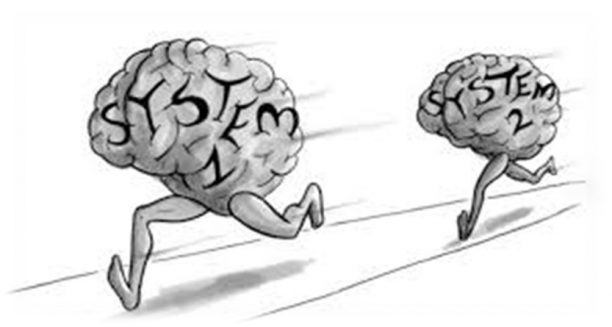“The world as we have created it is a process of our thinking. It cannot be changed without changing our thinking”
Albert Einstein 1879 – 1955
Our brains are being challenged by information overload and the constant pressure of having to deliver results quickly and make decisions fast. As humans, we cope with these demands by aggressively filtering the information we are exposed to and making decisions with limited data. These strategies work for us much of the time, but they don’t work in all contexts and knowing more about how we think can help us choose what approach will work better in different situations.
Our human superpower, the ability to reason and think deeply, and make informed decisions, seems to be being compromised (politicians using Twitter is a good example!) but we can do something about it.
System 1 and System 2 Thinking
In Daniel Kahneman’s book ‘Thinking Fast and Slow’ he explains that there are two main systems of thought that drive our reasoning and decision making. He calls them System 1 and System 2. These are not descriptions of specific parts of our brain, but they represent how we use and process information.
System 1 is fast thinking – it is quick, automatic, and requires little effort. It is the instinctive and emotionally-driven thinking that, for example, causes us to react with fear and anxiety when we hear about a workplace change that is about to be implemented. We recall a change that didn’t go well and react accordingly, instead of thinking more deeply to remind ourselves of the many other changes we have experienced that worked well.
System 2 is slow thinking – it is deliberate, effortful, logical and it is the kind of analytical thinking that, for example, helps us remember that the last change we had at work was actually pretty positive for us. In fact, instead of it having a negative result, we took on a more interesting role and learned new skills.
These two systems enable our brains to operate efficiently. System 1 is the most used, helping our brain make quick decisions using minimal information and least effort. It quickly creates a belief about something and then confirms it, but the downside of such fast decision making can mean that we resort to our biases to make decisions.
System 2 is like the supervisor, monitoring our thoughts and correcting them, but it takes a lot of effort to process information slowly and deliberately and it has a tendency to be lazy. So how do we train and optimise our capacity for System 2 thinking?
Building System 2 Capacity
Firstly, we need to build our awareness of these 2 modes of thinking and start to notice which ones we are applying to different situations. When we decide to make a job offer to an applicant for a critical role, are we using System 1 or System 2 thinking? Are we seeking more data which might lengthen the process and delay a decision or relying on our intuitive feel after an interview?
Secondly, we need to ask ourselves some powerful, reflective questions:-
• does this issue need more thinking time?
• what other information is available that I should be factoring into my decision making?
• if I slowed down and took a more deliberative approach this time, would this produce a better outcome?
Thirdly, we can take steps to build our understanding of how our brain works. We can learn how our survival mechanisms influence what we pay attention to, and how and why, we have developed system 1 and 2 thinking. When we know that our brain naturally defaults to the negative and we are biologically designed to take mental shortcuts, we can understand how we are prone to jumping to conclusions and making assumptions (System 1). We can also recognise the importance of building a strong System 2 capability.
Finally, we can learn how important it is to look after ourselves through focusing on our self-care. For more information on this see our Gamechanger program. When we are tired, it is hard to defend a System 1 takeover, so we need to rest, refresh and energise ourselves to have the capacity to access System 2 Thinking.
Would you like to learn how to use your brain more effectively to:
• avoid the common thinking traps
• create a more useful thinking state
• develop practical strategies to pause more and react less
• gain more choice over how you respond rather than react?
Then start a conversation with Anne on 0417 231 494 or email anne@rtpeople.com.au

